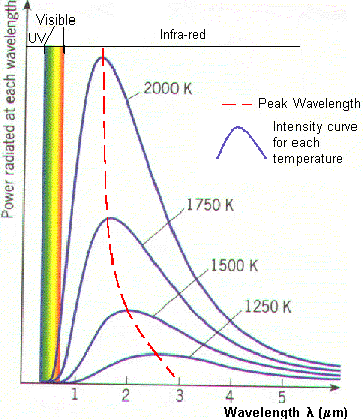INFRARED RADIATION
The infrared spectrum is an invisible portion of the electromagnetic spectrum that lies between approximately 750 nanometers (nm) and 1000 micrometers. It is divided into several bands including; the near infrared (NIR) from 750 – 1400 nm, the short-wavelength IR (SWIR) from 1400 – 3000 nm, the mid-infrared (MIR) from 3000 – 8000 nm, the long-wavelength IR (LWIR) from 8 – 15 microns, and the far infrared (FIR) beginning a approximately 15 microns.
Thermal or “blackbody” emitters are characterized by their temperature and relative emissivity which varies based on the material, surface condition, and other factors. The emissivity is defined at the ratio of the radiant intensity of the emitter to the radiant intensity of a true blackbody at the same temperature and has a value between 0 for a non-emitter and 1 for a true blackbody. Emitters with an emissivity less than 1 are called gray bodies.
BLACKBODY SPECTRAL INTENSITY
The blackbody spectrum is illustrated in the following figure.

The wavelength (λmax) at which the spectral intensity is a maximum for each absolute temperature, T, is given by Wein’s displacement law:
λmax = 2897.8 T-1 microns
The locus of these maxima is shown by the dashed red line in the above graph. For example, at an absolute temperature of 1250°K the maximum would occur at 2.32 microns. Also, the spectral intensity (Wλ) at λ max is given by
Wλ = 1.288 x 10-15 T5 watts cm-2 micron-1
